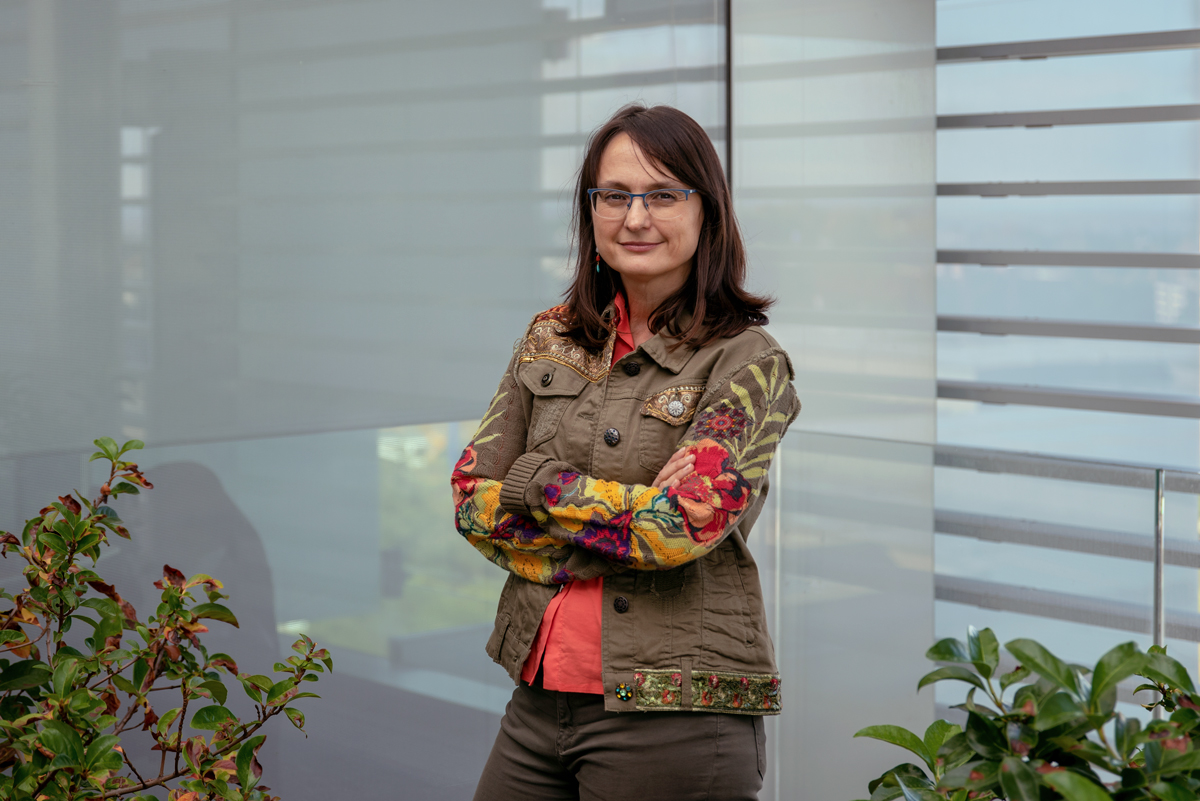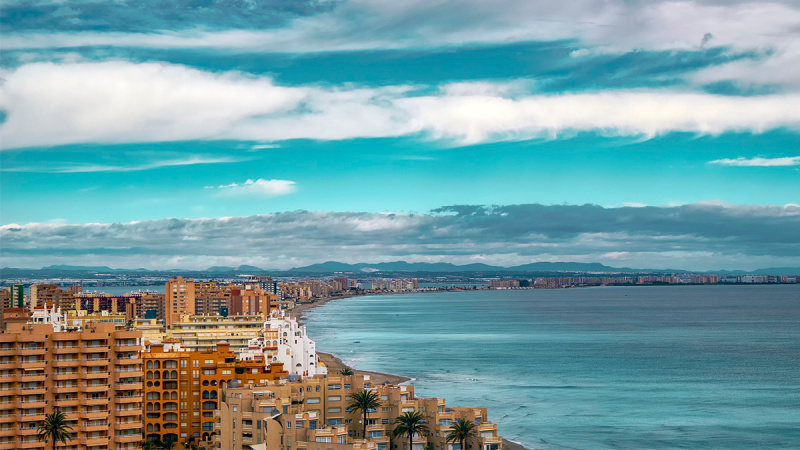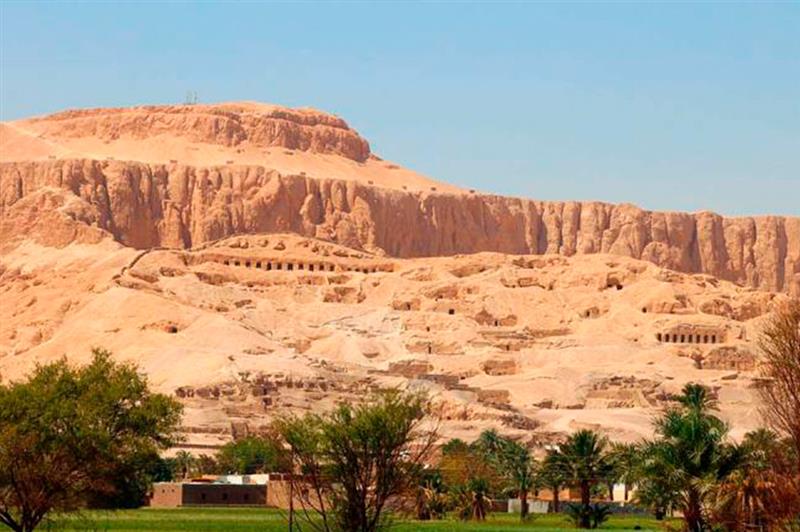
Paloma, Recuero de los Santos
Specialist in technological content generation for Telefónica Tech AI of Things´ digital channels. Degree in Physics and Master in Educational Technology. Passionate about "technologies for life", those that make our lives easier (which are not all of them), and pedagogy.

AI & Data
Green data centers: fighting climate pollution from Internet use
Do you have any idea how the Internet affects the environment? According to World Bank data, 48.5% of the world's population was already connected to the Internet in 2017 (of course very unevenly, from 1% in countries like Eritrea, to 98% in the most developed countries). And the number is growing steadily. So much so, that since January 2018, the number of people who have connected to the Internet for the first time has increased by 9%, reaching 4.39 billion users in 2019, Let's see how this impact is generated and what we can do to reduce it as much as possible. Figure 1: Evolution of the percentage of the world's population connected to the Internet (World Bank) Data One of the most easily identifiable consequences of this exponential growth is the parallel generation of large volumes of data. In fact, the level of data generated each week worldwide exceeds that accumulated in the last 1000 years of human history. The growing demand for data exchange and the volume of information stored in the cloud has raised the need to build ever-larger storage and processing spaces. These facilities, which operate 24 hours a day, 7 days a week, and under very specific temperature and humidity conditions, can consume more energy than large countries. And their number is growing every day. In fact, the company Cisco Systems, estimates that the number of hyperscale data centers in the world will increase from 259 in 2015 to 485 by 2020 Devices In addition to the implications derived from the unstoppable growth of data, there are others that could pass unnoticed. Talking about devices, on one hand, we must take into account the impact of their manufacture, both in terms of the use of very specific raw materials and energy resources, as well as the way in which we dispose of them when they are no longer useful (technological waste). Moreover, other "contributions" related to transportation, logistics, etc. should be added. Can the impact of internet use on our environment be somehow measured? The answer is "yes", and to do so, what we do is to quantify its carbon footprint. What is the carbon footprint of the Internet? The carbon footprint is a way of quantifying the greenhouse gas emissions released into the atmosphere as a result of a given activity. It is used as a tool to raise awareness of the impact of each activity on global warming. And yes, it is possible to calculate the carbon footprint generated by each email sent (a high percentage of which is unwanted), each tweet, each Google search, each photo uploaded to a social network... This revealed that data centers are one of the most polluting industries in the world. So much so that, if we do nothing to prevent it, the impact of ICT industries on the generation of greenhouse gases could reach values equivalent to 50% of the impact generated by the use of fossil fuels in the transport sector by 2040. Information and communication technology (ICT) equipment and services consume more than 8% of the EU's electrical energy and produce around 4% of its CO2 emissions. These divs could double by 2020. European Commission Digital Agency (September 2010) That is why, despite being a great challenge, the EU has set out a voluntary Code of Conduct to improve the efficiency of data centers and reduce energy consumption since 2008, which many companies have already joined. How can we reduce the effect of ICT on global warming? As individuals, we can take actions such as unsubscribing from newsletters that do not interest us, avoiding what is known as "latent pollution", due to the unnecessary storage of e-mails. We can also reduce our queries to Google, and avoid spending hours watching videos of kittens on Youtube or connected to social networks. In short, making responsible use of the Internet, being aware that each of these actions is a drop in the ocean, yes, but it is a sum and follows the overall balance, and we are many millions of people who "play our part". However, the lion's share lies in achieving more efficient and environmentally friendly data centers: the "green datacenters" or "green" data centers. Green datacenters. In 2017, Greenpeace USA produced a report "Clicking Clean: Who's Winning the Race to Create a Green Internet 2017?" that analyzed the energy footprints of the largest data centers and nearly 70 of the world's most popular sites and apps and explained the situation in a didactic video: He urged the major Internet companies to stop using outdated and polluting "dirty" energies, and to start covering their energy needs 100% with renewable energies such as hydro and wind sources. As a result of this interest, green data centers emerged, which are those that adopt sustainable technological solutions that contribute to improving energy efficiency and, therefore, to economic and environmental sustainability. The environmental conditions in some countries such as Ireland, Norway, Iceland, Sweden, etc. have turned them into true "superpowers" of green data centers. For example, in Norway, energy-efficient and sustainable data centers are built next to fjords. They use cooling systems that carry water, at 8ºC, from the fjord to the station without using electrical energy, only with the help of gravity, and without the need to use refrigerant gases, which ensures that it is a sustainable plant with zero emissions. In other cases, data centers are built underground, such as the Lefdal Mine Datacenter, which, located in a former mine at a depth of more than 600 meters, obtains its energy supply from a nearby hydroelectric power station; or even underwater, such as Microsoft's Nactik project in the Shetland Islands. Conclusion The information and communication technologies (ICT) sector must be a pioneer in the adoption of sustainable technological solutions that contribute to improving energy efficiency and, therefore, to economic and environmental sustainability. One of the main advances towards this sustainability is the evolution of traditional data centers towards "hyperscale" data centers. These centers achieve significant savings in energy consumption by using large arrays of commodity servers designed for specific tasks instead of conventional servers, and by adopting the latest advances in cooling. On the other hand, companies such as Google have achieved significant reductions in the energy consumption of their data centers by optimizing the use of their cooling systems using artificial intelligence algorithms. Finally, we cannot forget that many start-ups and large companies such as Intel and AMD are developing semiconductors to manufacture new microchips based on technologies such as photonics to power neural networks and other artificial intelligence tools that consume much less energy. In short, while technological progress poses significant challenges to environmental conservation, at the same time, every day, it offers new solutions. Read the original post in Spanish here.
February 22, 2022

AI & Data
A digital twin to save the Mar Menor
The Mar Menor, Europe's largest saltwater lagoon, is suffering from severe degradation due to various socio-environmental factors. The Smartlagoon project, funded by the European Commission, kicks off the efforts to achieve the lagoon's sustainability. Despite being an ecosystem of great environmental and socio-economic value, the strong climatic and anthropocentric pressures on the Mar Menor triggered a real environmental collapse in October 2019. The effects of a ‘DANA’ (a short period of intense rainfall) that hit the region at that time, added to the serious problem of the eutrophication of its waters and resulted in the desolate image of tons of fish dead due to asphyxiation. In addition to its ecological interest, the Mar Menor also has great cultural value, and treasures important remains of palaeontological, archaeological, historical and anthropological heritage. It is therefore vitally important to understand how this situation has come about and to take action to reverse it. Figure 1: Natural Areas of Campo de Cartagena (Murcia)-Nanosanchez, Public domain. (Enlarge) How did this situation come about? Throughout its history, the Mar Menor has undergone a process of transformation, due to human intervention, which has modified its physical and natural characteristics. The main causes of its current difficult situation are, for example: Contamination by organic waste and fertilizers, landfills and coastal works, dredging to extract sand, accelerated and poorly planned urban growth, Intense pressure from tourism. Marinas and artificial beaches where there used to be seaside resorts. Wetlands and altered riverbanks. Muddy seabeds. Uncontrolled proliferation of algae due to excess nutrients from illegal agricultural drainage. Dumping of sewage. Degradation of dune systems. Natural spaces overwhelmed by tourist pressure... Figure 2: Deterioration of the salt marshes of the Mar Menor The causes seem clear, but how can this difficult situation be resolved? The SmartLagoon project The SMARTLAGOON project, funded by the European Commission under the Horizon2020 research and innovation program, will combine new sensing technologies, based on artificial intelligence and IoT, to create a digital twin of the lagoon. It is an international project, coordinated by the Catholic University of Murcia, with the participation of the following institutions and companies: The Polytechnic University of Valencia and Vielca Ingenieros S.A (Spain), WaterITech ApS (Denmark), Uppsala University (Sweden), Norwegian Institute for Water Research (Norway), Università di Bologna (Italy) and Photrack, AG (Switzerland). As we already told you in one of our blogs, a digital twin is nothing more than an innovative virtual model of the lagoon. Its main objective is to gain an in-depth understanding of the socio-environmental interrelationships affecting coastal lagoons and their ecosystem. To do so, it will combine data from IoT sensors and satellite data with human behavioral data (social network data, economic data, etc.), data from open repositories (open data), and citizen science. Thus, by combining new sensing technologies based on artificial intelligence with IoT infrastructures, the digital twin of the lagoon will replicate the physical processes that occur in it. In this way, it will be possible to know in advance the impact of each of the actions carried out by the sectors involved. The Smartlagoon tool, funded by the European Commission, has a budget of 3,972,000 euros. It will be developed jointly with citizens, policy makers and other stakeholders to capture their needs and requirements. An agile methodology will be followed to ensure practical and useful results for this particular scenario in the first instance, but with the aim of extending to other coastal gaps in the future. We will keep a close eye on the results. Not only because of the importance of recovery of the Mar Menor; but also because of how the combined application of data technologies, IoT and Artificial Intelligence can help us to conserve our environment. References: Mar Menor: historia profunda de un desastre La causa de la muerte de los peces en el Mar Menor Innovative modelling approaches for predicting Socio-environMentAl evolution in highly anthRopized coasTal LAGOONs To keep up to date with Telefónica's Internet of Things, visit our website or follow us on Twitter, LinkedIn and YouTube
April 12, 2021

AI & Data
Internet of Things… Archaeological Sites
At the end of 2019, according to IoT Analytics, there were already 9.5 billion connected devices for consumers, businesses and scientists. The forecast for 2025 is three times this div because the formula: large volumes of data + analysis + expert knowledge in one domain is useful … for almost anything. From managing devices in the home to controlling pollution or traffic in cities to using water more efficiently in agriculture or helping to control the spread of a virus. In today's post, we will see how it can also be used to protect our archaeological treasures, with a world-famous example: The Valley of the Kings in Egypt. IoT Solutions for Geology: Catastrophe Prevention Normally, IoT solutions for Geology monitor the natural environment to predict and prevent natural disasters. Thus, there are solutions aimed at predicting overflows in rivers, subsidence in tunnels, or earth movements. Other applications are aimed at understanding the impact of climate change on the stability of certain rock formations. The importance of this study is evident when these "rock formations" are part of one of the most important archaeological sites in the world, such as the Valley of the Kings, located on the outskirts of Luxor, on the banks of the Nile. The Valley of the Kings is an ancient Egyptian necropolis where the tombs of most of the pharaohs of the New Empire are located. Among them, the best known is KV62, the tomb of Tutankhamun (c. 1342 - c. 1325 BC), discovered by Howard Carter in 1922. To guarantee the best conservation of the tombs and the safety of the millions of tourists who visit them every year, it is essential to control the stability of the limestone formations that surround the valley, and which can be impacted by both seismic and meteorological phenomena. The Valley of the Kings project To find out more, a team from York University (Canada), the Department of Earth Sciences at the ETH Zurich and the University of Basel carried out a study on the stability of the rocky cliff above tomb KV42. The researchers developed mathematical modelling of the behaviour of the rock, analysing factors such as moisture absorption, volume changes due to temperature changes, displacements/fractures caused by small seismic movements or torrential rainfall etc. The role of IoT sensors The researchers installed a set of IoT sensors to monitor the rock and its environment and generate the data to train the model. In particular, a Plug & Sense Smart Agriculture Pro weather station from one of our partners, the company Libelium, was installed. The station allows the measurement of wind speed and direction, rainfall volume, solar radiation, temperature (air and rock), and degree of humidity. Additional sensors were added to the station, which is powered by solar energy: - A dendrometer, to measure how tree growth influences the opening of the fracture - A seismometer Figure 1: Sensors monitoring the crack (source) The sensors record data every 15 minutes, store it in memory and then send it to a remote server via a cellular network (3G/4G). In this way, the impact of erosion on the crack can be controlled, and an early warning can be generated in the event of a risk of fracture, thus ensuring the preservation of the historical heritage site and the safety of visitors. Conclusion Technologies for monitoring cracks in solid materials are becoming increasingly important, not only in historical sites but also in any other type of natural or human structures due to the negative impact on them of phenomena related to climate change. References: Alcaino-Olivares, Rodrigo & Perras, Matthew & Ziegler, Martin & Maissen, Jasmin. (2019). Cliff stability at tomb KV42 in the Valley of the Kings, Egypt: A first approach to numerical modelling and site investigation. Original Post in Spanish Translated By: Patrick Buckley. LUCA visit our website, subscribe to LUCA Data Speaks or follow us on Twitter, LinkedIn or YouTube .
October 1, 2020
Find out more about us
-
🏥 Fundación Vithas is taking an important step in the use of clinical data to drive new lines of research and improve healthcare.
DECEMBER 4, 2025
-
A day with Edward Holman, Marketing Communications Associate at Telefónica Tech UK&I. 💙 Press play and join him for a day!
DECEMBER 5, 2025
-
🎓 Workshop at the University of Vigo to support students in developing IoT solutions, from the idea to the market.
DECEMBER 5, 2025
 Hybrid Cloud
Hybrid Cloud Cyber Security & NaaS
Cyber Security & NaaS AI & Data
AI & Data IoT & Connectivity
IoT & Connectivity Business Applications
Business Applications Intelligent Workplace
Intelligent Workplace Consulting & Professional Services
Consulting & Professional Services Small Medium Enterprise
Small Medium Enterprise Health and Social Care
Health and Social Care Industry
Industry Retail
Retail Tourism and Leisure
Tourism and Leisure Transport & Logistics
Transport & Logistics Energy & Utilities
Energy & Utilities Banking and Finance
Banking and Finance Sports
Sports Smart Cities
Smart Cities